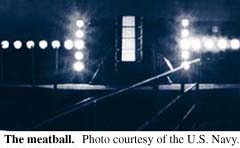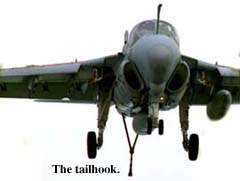 |

 It's been said steering a jet onto a pitching aircraft carrier is like "landing on a postage stamp." Says one pilot: "It's like taking 40,000 pounds of machinery and passing it through the eye of a needle." For new pilots, the exercise is terrifying. If you come in too low, you hit the 60-foot wall of the carrier; if you're too high, you miss the cables that snag the jet to a halt.
It's been said steering a jet onto a pitching aircraft carrier is like "landing on a postage stamp." Says one pilot: "It's like taking 40,000 pounds of machinery and passing it through the eye of a needle." For new pilots, the exercise is terrifying. If you come in too low, you hit the 60-foot wall of the carrier; if you're too high, you miss the cables that snag the jet to a halt.
 If on land, a pilot might choose an alternative runway if the weather deteriorates, fuel is running out, or if he is having difficulty getting into a flight pattern. Not so at sea. The pilot must keep trying until he lands, even if it means re-fueling in mid-air.
If on land, a pilot might choose an alternative runway if the weather deteriorates, fuel is running out, or if he is having difficulty getting into a flight pattern. Not so at sea. The pilot must keep trying until he lands, even if it means re-fueling in mid-air.
 The pilot knows he is on the correct glide path if an amber light on the deck, known as the ball, is lined up with a horizontal row of green lights. If the ball is too, high, so is the plane. Through a Fresnal lens system, the amber ball appears to move up and down to alert the pilot to whether he is too high or too low.
The pilot knows he is on the correct glide path if an amber light on the deck, known as the ball, is lined up with a horizontal row of green lights. If the ball is too, high, so is the plane. Through a Fresnal lens system, the amber ball appears to move up and down to alert the pilot to whether he is too high or too low.

 The Plane hits the deck at 140-150 miles per hour. A tailhook is a metal hook bolted to an 8-foot bar extending from the belly of an aircraft. Upon landing, the hook catches one of several arresting wires stretched across the landing deck. The arresting wires are wound steel cables just over an inch thick that are adjusted for tension depending on the weight and type of the aircraft. Hooking onto a wire brings a 150 mph plane to a stop in the space of about 300 feet. Once the plane has stopped, a man signals the pilot to cut power and raise hook, and then directs the jet clear to be refueled, rearmed and remanned.
The Plane hits the deck at 140-150 miles per hour. A tailhook is a metal hook bolted to an 8-foot bar extending from the belly of an aircraft. Upon landing, the hook catches one of several arresting wires stretched across the landing deck. The arresting wires are wound steel cables just over an inch thick that are adjusted for tension depending on the weight and type of the aircraft. Hooking onto a wire brings a 150 mph plane to a stop in the space of about 300 feet. Once the plane has stopped, a man signals the pilot to cut power and raise hook, and then directs the jet clear to be refueled, rearmed and remanned.
|